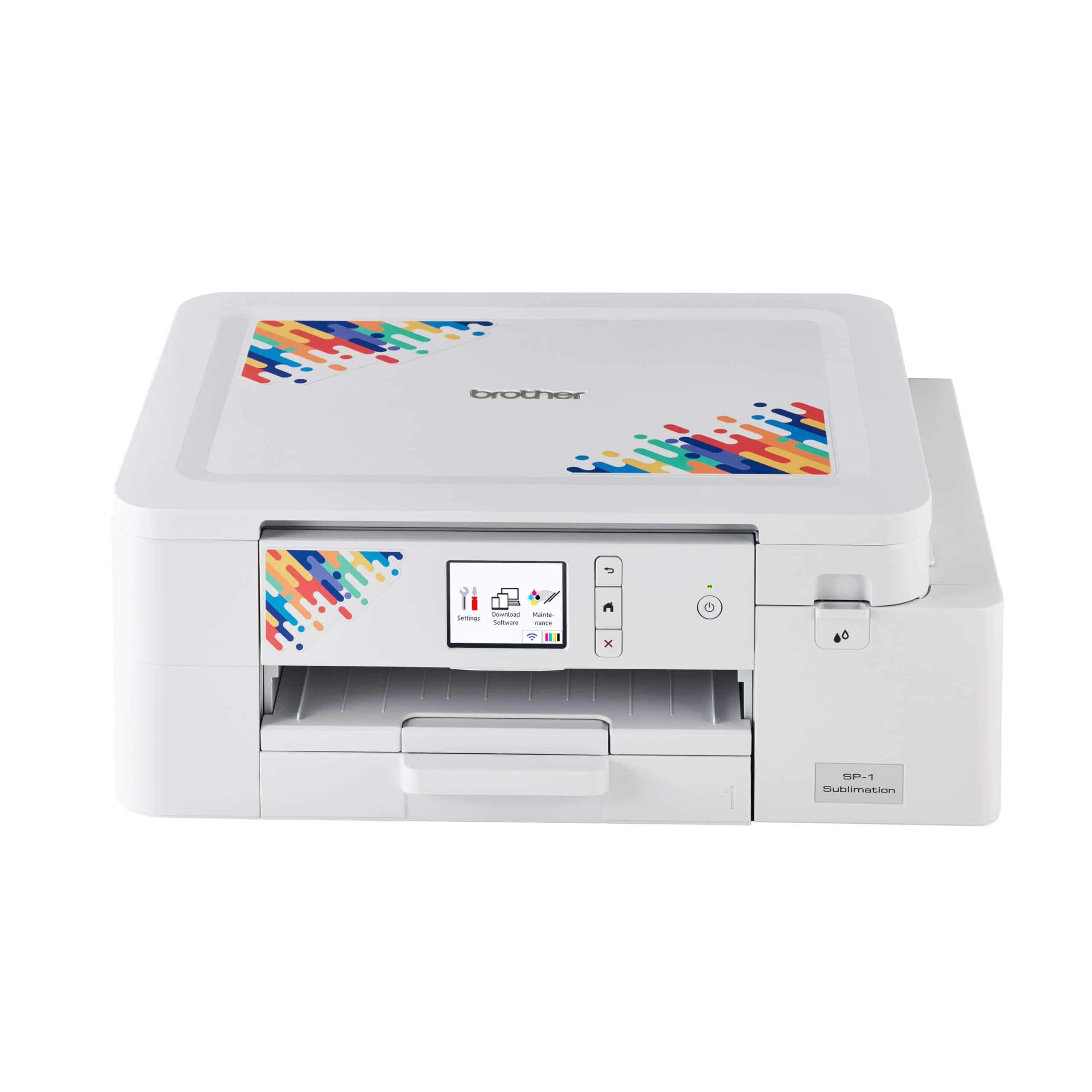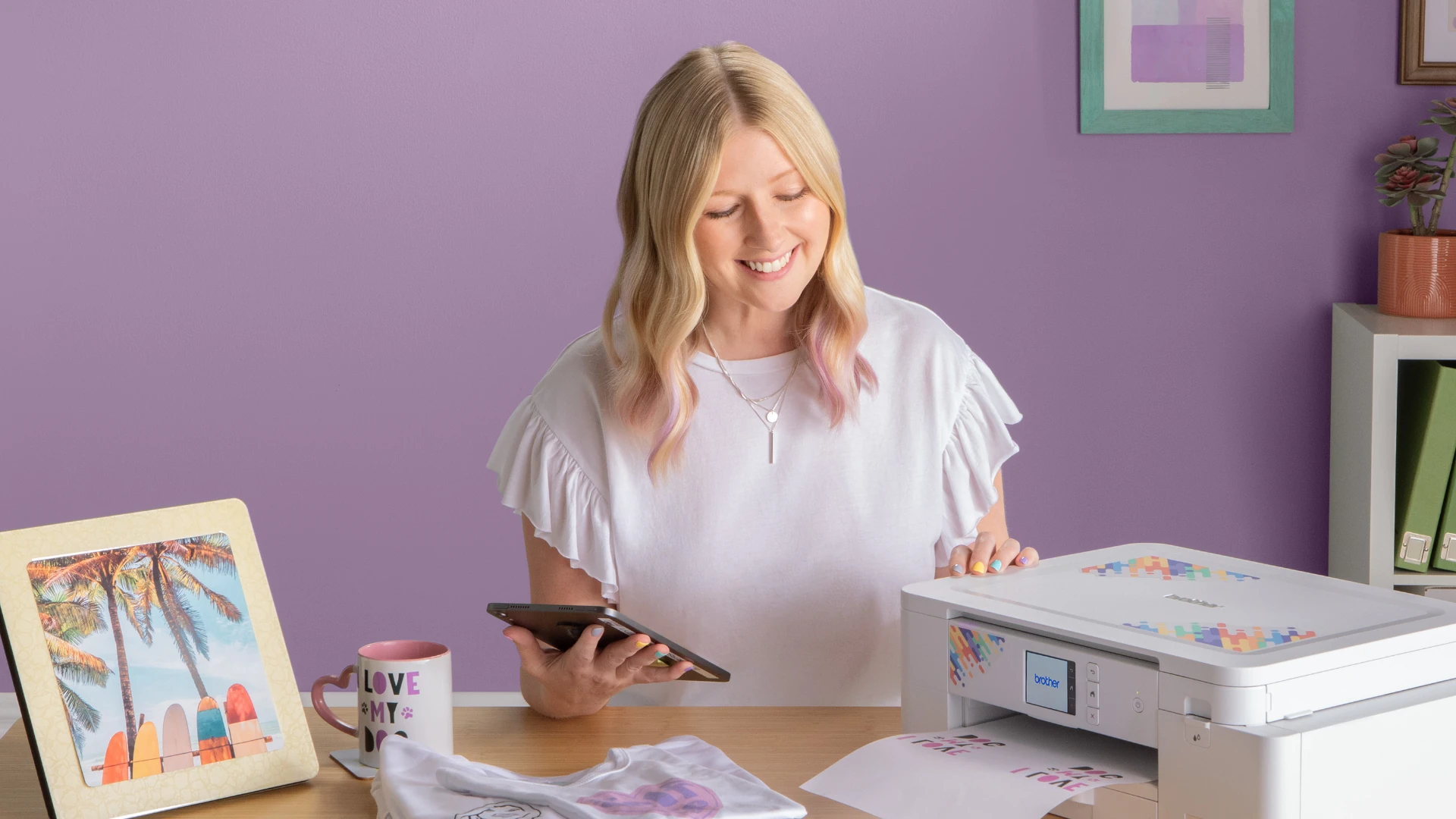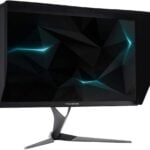Sublimation printing has become one of the most popular and versatile methods for transferring vibrant, full-color designs onto everything from t-shirts and mugs to signage and home décor. As we move through 2025, major brands like Epson, Brother, and Sawgrass are pushing the envelope with faster, more efficient, and environmentally conscious printing solutions—making this an exciting time for hobbyists, creators, and print businesses alike.
Unlike traditional inkjet printers, sublimation printers use a chemical process where solid dye-based inks convert directly into gas under heat and bond with polyester or polymer-coated surfaces. This results in crisp, permanent images that won’t crack, fade, or peel over time. And with the rapid evolution of this space, choosing the right sublimation printer in 2025 means weighing speed, print size, ink quality, and long-term cost efficiency.
Let’s take a look at the top contenders—and the major industry shifts behind them.

What’s New in Sublimation Printing in 2025?
The dye-sublimation market has grown dramatically, expected to reach $11.8 billion globally by the end of this year. That growth is being driven by:
- Booming Demand in textile printing, merchandise customization, and promotional products.
- Sustainable Practices, like eco-friendly dye inks and reduced energy usage in printers.
- New Form Factors, including 3D sublimation for curved and complex objects (tumblers, phone cases, etc.).
- High-Speed Printing for commercial operations, reducing turnaround time and improving print shop productivity.
Epson is leading this wave with its SureColor F9570 and F9570H, which are fast, precise, and come with expanded ink sets for exceptional color fidelity—ideal for textile and promotional item printing. For high-volume shops, the SureColor F11070H with six-color ink support provides increased versatility and throughput.
On the design front, Epson’s newest printers have also earned accolades, including iF Design Awards, for blending performance with modern usability. The company showcased these innovations at the ISA Sign Expo 2025, where sustainability and workflow automation were big themes.
The 5 Best Sublimation Printers of 2025
Here’s a ranked breakdown of the top sublimation printers available this year, each with unique strengths depending on your needs and budget:
1. Brother SP-1 – Best Sublimation Printer Overall
- Why it’s great: This all-in-one workhorse offers fast, consistent results with excellent color accuracy and easy-to-use software.
- Key features:
- Industrial-grade performance
- Built-in design tools
- Compact but powerful for small business use
Perfect for: Small businesses and power users looking for commercial-level results without investing in bulkier, high-end industrial models.
2. Epson EcoTank ET-15000 – Best Large Format Choice
- Why it’s great: A wide-format sublimation-ready printer that’s affordable and efficient for creating larger designs.
- Key features:
- Prints up to 13” x 19”
- Refillable ink tanks = huge savings over time
- Excellent color vibrancy
Perfect for: Designers and shops printing banners, pillowcases, or larger textile panels.
3. Sawgrass UHD Virtuoso SG500 – Best Professional-Grade Printer
- Why it’s great: Sawgrass specializes in sublimation, and the SG500 delivers unmatched color control and tech support.
- Key features:
- Dedicated sublimation software (Print Manager)
- UHD ink technology for razor-sharp results
- Great for producing client-ready products
Perfect for: Professionals or Etsy sellers who want gallery-quality output and reliability.
4. Canon SELPHY CP1500 – Best Budget Sublimation Printer
- Why it’s great: While technically not dye-sub in the industrial sense, Canon’s CP1500 uses thermal dye-sub technology to print high-quality photos on the go.
- Key features:
- Portable and compact
- Great for event booths and personal photo gifts
- Budget-conscious option
Perfect for: Casual users and travelers who want instant, durable prints without a studio setup.
5. Epson EcoTank ET-2720 – Best Inkjet Sublimation Printer
- Why it’s great: Budget-friendly and modifiable for sublimation use with third-party inks.
- Key features:
- Low-cost entry point
- Compact and reliable
- Ideal for hobbyists and beginners
Perfect for: Crafters getting into sublimation who want to start small but still get vivid results.
Key Takeaways
- Sublimation printers use heat and pressure to transform special inks into gas that permanently bonds with materials.
- Modern sublimation technology enables vibrant, durable designs on fabrics, ceramics, and other polymer-coated surfaces.
- These printers have become essential tools for personalization businesses, textile production, and creative hobbyists.
Fundamentals of Sublimation Printing
From high-volume textile production to at-home DIY custom gear, sublimation printing continues to evolve in both power and accessibility. Brands like Brother and Epson are leading the way with innovation, sustainability, and performance, while options from Sawgrass and Canon ensure there’s a high-quality solution at every budget level.
Sublimation printing transforms designs into permanent, vibrant transfers using heat and pressure. This specialized printing method creates durable images that become part of the material rather than sitting on top of it.
Comparing Sublimation Printers with Other Technologies
Sublimation printers differ significantly from traditional printing methods. Unlike inkjet printers that place droplets on surfaces, sublimation printers convert solid ink directly to gas that penetrates materials.
Screen printing requires separate screens for each color and works best for bulk orders. Sublimation, however, allows for detailed, multi-colored designs in single prints with no minimum quantities.
UV printers cure ink instantly with ultraviolet light, allowing printing on almost any surface. Eco-solvent printers use chemical-based inks that adhere to many materials but require drying time. Sublimation printers, by contrast, need heat application after printing but create more durable results on specific materials.
The main advantage of sublimation is color vibrancy and durability. Unlike water-based inks that can fade or crack, sublimated designs become part of the material.
Anatomy of a Sublimation Printer
A sublimation printer looks similar to a standard inkjet printer but contains key differences. It features specialized print heads designed to work with thicker sublimation inks.
The ink delivery system in these printers often includes:
- Continuous ink supply systems (CISS)
- Specialized cartridges
- Precision ink flow regulators
Heat management components are crucial since sublimation printers operate at specific temperatures to ensure proper ink transfer. Most models include advanced color management systems that help achieve accurate color reproduction.
The printer connects to computers via USB or wireless technology. Modern sublimation printers often feature touchscreen interfaces for easier operation and maintenance.
The Sublimation Printing Process
Sublimation printing involves a two-step process. First, the image is printed in reverse onto special transfer paper using sublimation ink. This initial print looks flat and muted compared to the final result.
Next comes the heat press stage. The printed transfer paper is placed on the target material and subjected to high heat (around 375-400°F) and pressure for 30-60 seconds. During this process, the solid ink transforms directly into gas without becoming liquid first.
The gas penetrates the material’s polymer fibers and becomes permanently part of it once cooled. This creates images that won’t crack, peel, or wash away over time.
Temperature, pressure, and timing must be precise. Too little heat results in pale transfers, while too much can damage materials or cause colors to bleed.
Materials and Inks Used in Sublimation Printing
Sublimation works best on polyester fabrics and polymer-coated items. Materials need at least 60% polyester content for good results, with 100% polyester providing the brightest outcomes. Cotton fabrics won’t work with sublimation unless pre-treated with a polymer coating.
Common sublimation-friendly materials include:
- Polyester t-shirts and clothing
- Polymer-coated mugs and drinkware
- Mouse pads with fabric tops
- Specially coated metal sheets
- Polyester-based phone cases
Sublimation inks contain special dyes that convert from solid to gas when heated. These inks are different from standard inkjet inks and come in either cartridge form or bottle systems for bulk users. They create vibrant colors that bond with polymers at the molecular level.
The inks must be compatible with both the printer and the heat press equipment. High-quality sublimation inks produce sharper images with better color accuracy and longevity.
Applications and Advantages in Various Industries
Sublimation printing has transformed multiple industries with its ability to create vibrant, durable prints on various materials. This technology offers exceptional versatility while maintaining high-quality results that businesses and consumers alike have come to value.
Sublimation Printing in Fashion and Apparel
The fashion and textile industry has embraced sublimation printing for its ability to create detailed, colorful designs on polyester fabrics. This technology is particularly valuable for sportswear and athletic apparel where durability and color vibrancy are essential.
Manufacturers use heat press machines to transfer designs onto fabrics, creating permanent prints that won’t crack, fade, or peel even after multiple washes. This durability makes sublimation ideal for sports team uniforms and performance wear.
Fashion designers appreciate the ability to create custom patterns with no minimum order requirements. Small businesses can produce limited edition pieces or one-off designs cost-effectively.
The eco-friendly nature of sublimation also appeals to sustainable fashion brands, as the process uses less water than traditional dyeing methods and creates minimal waste.
Signage and Soft Signage Solutions
Sublimation printing has revolutionized the advertising and signage industry with its application in soft signage solutions. These lightweight fabric displays offer vivid colors and excellent detail that catch the eye.
Businesses prefer soft signage for trade shows and retail environments because the materials are:
- Lightweight and easy to transport
- Wrinkle-resistant
- Less expensive to ship than rigid alternatives
- Reusable and durable
Banners and display materials printed via sublimation maintain their appearance even in high-traffic areas. The images won’t scratch off or deteriorate quickly like some traditional printed materials.
For outdoor applications, sublimated fabrics offer UV resistance and weather durability that traditional paper signage cannot match.
High Demand for Personalized Products
The market for personalized products has grown exponentially, making sublimation printing increasingly valuable. This technology allows businesses to create custom promotional items quickly and efficiently.
Popular personalized products include:
- Custom mugs and drinkware
- Phone cases and accessories
- Promotional items like lanyards and keychains
- Custom t-shirts and apparel
Small businesses appreciate the low initial investment compared to other printing methods. A basic sublimation printer, heat press, and sublimation paper can launch a personalization business without significant capital.
The on-demand nature of sublimation reduces inventory costs since items can be produced as ordered. This advantage makes it particularly suited for e-commerce businesses offering custom merchandise.
Sublimation in Home Décor and Upholstery
Home décor represents a growing market for sublimation printing, with consumers seeking personalized and unique items for their living spaces. The technology produces high-quality prints on various materials used in interior design.
Popular home décor applications include:
- Throw pillows with custom designs
- Photo panels and canvas prints
- Decorative ceramic tiles
- Custom upholstery fabrics
Designers value sublimation for its ability to recreate complex patterns and photographic images with excellent color accuracy. The results maintain their vibrancy even in areas exposed to sunlight.
The versatility of sublimation allows for customization of nearly any polyester-coated surface, giving interior designers unprecedented creative freedom. Even one-of-a-kind furniture pieces can be created using sublimated upholstery fabrics.
Frequently Asked Questions
Sublimation printing involves several technical aspects that often raise questions for both beginners and experienced users. Here are answers to some common questions about sublimation printers.
What are the primary uses for a sublimation printer?
Sublimation printers are widely used for creating custom apparel such as t-shirts, hoodies, and hats. They excel at producing vibrant designs on polyester fabrics.
Many businesses use these printers for creating personalized gifts like mugs, phone cases, and mousepads. The dye-sublimation process creates permanent, fade-resistant images.
Photographers and artists often use sublimation printing for high-quality photo prints and artwork reproductions. The technology captures fine details and rich colors effectively.
How does a sublimation printer differ from a traditional inkjet printer?
A sublimation printer uses special dye-based inks that turn from solid to gas when heated, skipping the liquid phase. This process allows the ink to bond permanently with polymer-coated surfaces.
Traditional inkjet printers typically use liquid ink that sits on top of paper rather than bonding with it. Sublimation inks penetrate the surface, creating more durable prints.
Many sublimation printers are actually modified inkjet printers. According to the search results, standard Epson or Ricoh inkjet printers can be fitted with refillable sublimation ink cartridges.
What are some of the best sublimation printers for small businesses?
The Sawgrass SG500 and SG1000 are popular choices for small businesses due to their reliability and specialized design for sublimation printing. They offer excellent color accuracy and consistency.
Epson F570 and F170 models are professional-grade sublimation printers that deliver high-quality results. These models come with dedicated sublimation ink systems.
For businesses requiring higher production capacity, the Mimaki TS series offers industrial-grade performance with faster printing speeds and larger format capabilities.
Can you recommend a sublimation printer suitable for beginners?
Epson EcoTank printers are highly recommended for beginners. According to the search results, they come with large ink tanks and can be converted for sublimation use.
The Epson EcoTank ET-2800 and ET-4800 are particularly popular entry-level models. They’re affordable and relatively easy to set up with sublimation inks.
Beginners can also consider the Sawgrass SG500, which is designed specifically for sublimation printing. While more expensive than converted printers, it eliminates many setup challenges.
What are the main disadvantages associated with using sublimation printers?
Sublimation printing only works effectively on polyester or polymer-coated surfaces. This limits the materials that can be used for projects.
The initial investment can be high. Between the printer, special inks, heat press, and materials, startup costs add up quickly.
Colors can sometimes appear different on the final product compared to the digital design. This color shifting requires experience to anticipate and adjust for.
Which Epson models are considered optimal for sublimation printing?
The Epson EcoTank series, particularly the ET-15000, ET-8550, and ET-4700, are considered excellent for sublimation conversion. Their refillable ink tank systems make them cost-effective for long-term use.
Epson’s WorkForce WF-7720 and WF-7710 are popular wide-format options. These models can handle larger transfer sheets for bigger projects.
The Epson SureColor F170 is a dedicated sublimation printer that comes ready to use without conversion. It offers professional results with minimal setup for those who prefer an out-of-the-box solution.







